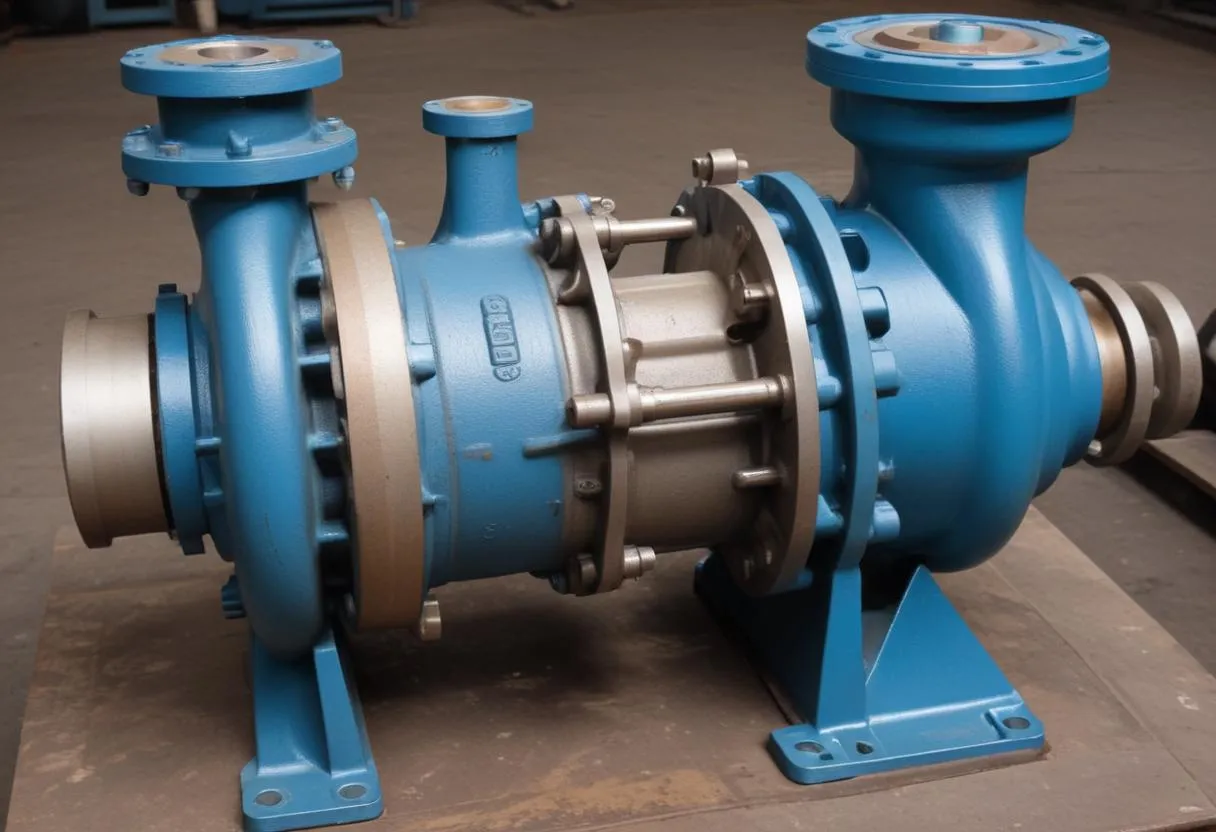 Centrifugal pumps operate on the principle of converting rotational kinetic energy to the hydrodynamic energy of the fluid flow. The core component of these pumps is the impeller, which is a rotating disk with a series of backward-curved vanes attached to it. As the impeller rotates, fluid entering the pump is hurled outward from the impeller blades to the volute or casing, creating a vacuum at the impeller’s eye which draws more fluid into the pump.
Centrifugal pumps operate on the principle of converting rotational kinetic energy to the hydrodynamic energy of the fluid flow. The core component of these pumps is the impeller, which is a rotating disk with a series of backward-curved vanes attached to it. As the impeller rotates, fluid entering the pump is hurled outward from the impeller blades to the volute or casing, creating a vacuum at the impeller’s eye which draws more fluid into the pump.
The operation can be further understood by examining the following key parts and their functions:
| Part | Function |
|---|---|
| Impeller | Transfers energy from the motor to the fluid by accelerating the fluid radially outwards |
| Casing (Volute) | Converts the kinetic energy of the fluid into pressure energy and helps guide the fluid to the pump outlet |
| Suction pipe | A pipe that connects the source of fluid to the pump, featuring a suction valve to control fluid entry |
| Discharge pipe | Channel through which the pressurized fluid is dispensed from the pump |
The performance of a centrifugal pump is often characterized by its flow capacity, pump head, efficiency, power consumption, and Net Positive Suction Head (NPSH). These parameters help define the operating conditions under which the pump can perform effectively without cavitation — a phenomenon where vapor bubbles form in the fluid due to low pressure, which can cause physical damage when they collapse.
- Flow rate: This is the volume of fluid that the pump can move per unit of time, typically measured in gallons per minute (gpm).
- Total dynamic head: The total pressure head when the fluid exits the pump, represented in units of distance (like meters or feet).
- Efficiency: A measure of how well the pump converts the input energy (typically electrical) to hydraulic energy.
- Power consumption: Directly related to the flow rate and the head, indicating how much energy is needed to operate the pump.
- NPSH: Required to avoid cavitation, it measures how much higher the pressure at the suction side of the pump must be compared to the vapor pressure of the pump fluid.
To understand the operational dynamics, consider that the pump’s efficiency and performance are impacted by factors like the speed of the impeller and the diameter of the impeller. Modifying these can adjust the head and flow rate to meet specific requirements.
Furthermore, the operation of centrifugal pumps involves careful consideration of the installation environment and maintenance practices. Ensuring that the pump foundation is sound and that the alignment between the pump and its driver is precise can drastically reduce operational issues and increase the lifespan of the pump.
In summary, centrifugal pumps are versatile and widely used, but understanding their operational mechanics is essential for optimizing their performance and longevity within any system.
Benefits of using centrifugal pumps
Centrifugal pumps are celebrated for their impressive array of benefits that make them a preferable choice in various industrial, municipal, and commercial applications. Their design simplicity, efficiency, and versatility are just the tip of the iceberg when it comes to the advantages they offer.
1. Simplicity and Compact Design: One of the most significant advantages of centrifugal pumps is their straightforward and compact design. This simplicity facilitates easier installation, operation, and maintenance. Fewer parts also mean fewer potential failure points, which translates to lower maintenance costs and downtime.
2. Efficiency: Centrifugal pumps are highly efficient compared to other pump types. They are capable of handling large volumes of fluids, providing significant flow rates, and achieving substantial discharge pressures. The efficiency of a centrifugal pump generally increases with consistent and continuous operation. Adjustments to impeller size and speed can further optimize performance according to specific application needs.
3. Versatility: Another compelling benefit of centrifugal pumps is their versatility. They can handle a variety of fluid types, even those containing low to moderate viscosity or mixed with small particulate matter. This makes them suitable for a wide range of applications, from water distribution and wastewater management to chemical processing and pharmaceutical industries.
4. Low Initial and Operational Costs: When comparing the cost-effectiveness of different pump technologies, centrifugal pumps often come out on top due to their relatively low initial purchase cost and operational expenses. Their ability to operate for long periods with minimal intervention helps reduce overall lifecycle costs.
5. Durability and Reliability: Constructed from robust materials, centrifugal pumps are durable and can reliably perform under challenging conditions. Properly maintained, these pumps can have a long operational lifespan, making them a valuable investment for any facility.
6. Minimal Impact from Cavitation: With appropriate Net Positive Suction Head (NPSH) settings, centrifugal pumps can effectively minimize the risk of cavitation, which is a common problem in other pump types. This characteristic is crucial in applications where maintaining the integrity and functionality of the pump is paramount.
7. Ease of Maintenance: Due to their simple construction, centrifugal pumps are generally easier and cheaper to maintain compared to more complex machinery. Standard maintenance practices such as regular inspection, cleaning, and lubrication can prevent major failures and extend the pump’s operational life.
8. Safety Features: Centrifugal pumps typically come with various safety features that prevent overheating, overload, and other mechanical failures. These features ensure safe operation even under high-pressure conditions or when handling hazardous materials.
9. Scalability: As the needs of a process or facility change, centrifugal pumps can be adapted with relative ease. Modifications to the impeller and adjustments in motor power can accommodate varying flow rates and pressures without the need for complete pump replacement.
In industrial and commercial setups where reliability, durability, and cost-effectiveness are crucial, the benefits of utilizing centrifugal pumps cannot be overstated. Their ability to perform consistently across a spectrum of applications cements their position as a fundamental component of any efficient fluid handling system.
Challenges associated with centrifugal pumps
 While centrifugal pumps boast numerous advantages, they also come with certain inherent challenges that can affect their operation and suitability for specific applications. Understanding these drawbacks is crucial for assessing whether a centrifugal pump is the best choice for a given situation.
While centrifugal pumps boast numerous advantages, they also come with certain inherent challenges that can affect their operation and suitability for specific applications. Understanding these drawbacks is crucial for assessing whether a centrifugal pump is the best choice for a given situation.
1. Performance Limitations with High Viscosity Fluids: Centrifugal pumps are not ideal for pumping high viscosity fluids. As the viscosity of the fluid increases, the efficiency of the pump decreases significantly. This is due to the shearing action within the pump, which causes energy losses. For fluids with viscosities similar to water, centrifugal pumps perform efficiently, but they struggle with thicker fluids like oils or syrups.
2. Prone to Cavitation: Despite being less affected by cavitation when operated under the correct conditions, centrifugal pumps are still vulnerable to this damaging phenomenon under certain operational environments. Cavitation occurs when the local pressure in the pump falls below the vapor pressure of the liquid, leading to the formation of vapor bubbles which collapse and can cause significant wear on the impeller and other internal components. Ensuring adequate Net Positive Suction Head is critical to minimize this risk.
3. Overheating Due to Dry Running: Centrifugal pumps require a continuous flow of fluid to keep the pump cool and lubricated. Running these pumps dry can lead to overheating and eventual failure of the seal systems and bearings. This makes them unsuitable for applications where the flow can be highly variable or where pump priming might not always be guaranteed.
4. Limited Solids Handling Capability: These pumps are not typically designed to handle large or hard solids. The presence of solids can cause abrasion and erosion on the impeller blades and the pump housing, leading to a decreased operational life and diminished efficiency.
5. Complex Installation Requirements: Proper installation and alignment are critical to the successful operation of centrifugal pumps. Incorrect installation can lead to issues such as excessive vibration, premature bearing or seal failure, and inefficient operation. Ensuring that the pump is perfectly horizontal and adequately primed at installation demands careful attention to detail.
6. Need for Frequent Maintenance: While maintenance may be straightforward, centrifugal pumps do require frequent checks and balances. Components like the impeller, bearings, and seals need regular inspection and replacement to prevent failures. The schedule and diligence of maintenance activities can directly impact the reliability and lifespan of the pump.
| Challenge | Details |
|---|---|
| High Viscosity Fluids | Decreased efficiency with increased viscosity |
| Cavitation | Risk of impeller damage due to vapor bubble collapse |
| Dry Running | Potential for overheating and mechanical failure |
| Solids Handling | Limited capability to process fluids with solid particulates |
| Installation | Demand for precise alignment and setup to avoid operational issues |
| Maintenance | Requires consistent and skilled maintenance efforts |
In conclusion, while centrifugal pumps offer considerable benefits and are highly popular in various sectors, they may not be the most appropriate solution for every application. Evaluating their disadvantages in conjunction with their advantages is imperative to make well-informed decisions about their use in specific operational environments.